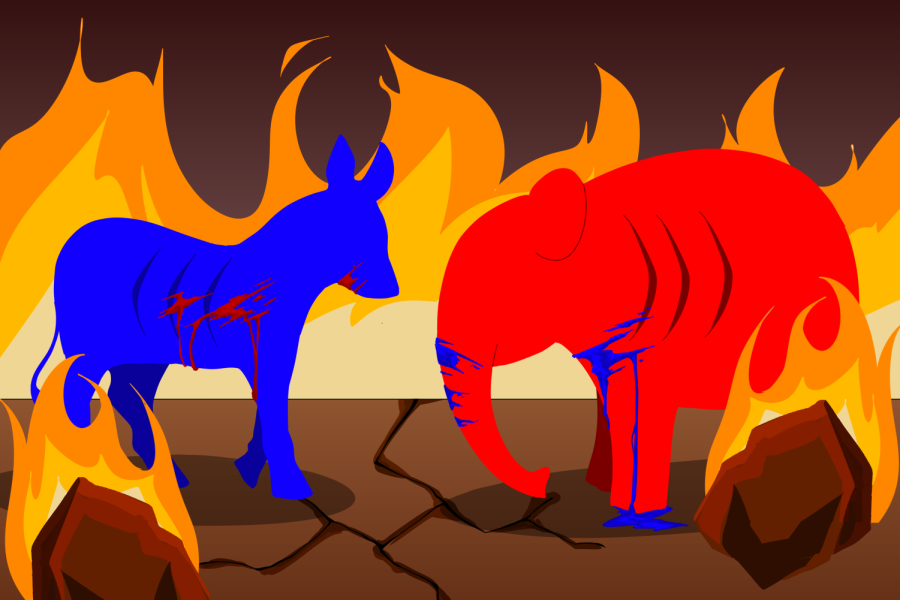Failure of the two party system
An illustration depicting the damage the two party system does to democracy. More than a quarter of Americans view both parties negatively, bringing into question whether constituent views are truly being heard on the political stage.
March 23, 2023
In the 2020 election between Donald Trump and Joe Biden, my dad found that he could not support either candidate: both Trump and Biden did not align with his political views. My dad asked, “What do you do when you don’t support either of the candidates?”
As a moderate voter, he believed that neither the Republican nor the Democratic Party was headed in the right direction. In the end, he voted based not on which candidate spoke to him the most, but based on which candidate he disliked less. With only two real choices, voters are forced to align themselves with one party, despite not feeling represented by that party.
More than a quarter of Americans view both parties negatively, according to a report from the Pew Research Center, pointing to the question of whether constituent views are truly being heard on the political stage. It is an American ideal that states the people should have a say in our government, but in the current two-party system, voting for an independent candidate who more closely aligns with one’s political views feels ineffectual, as they rarely win.
America takes pride in its diversity, consisting of a wide range of people and views that should be expressed. But with only two choices in most elections, that diversity of ideas can be suppressed, leading to a more homogenous Congress that fails to hear non-mainstream opinions.
Oftentimes, the two-party system enables party leaders to ignore constituent beliefs. 61% of Americans say that abortion should be legal in all or most cases. However, mainstream Republican Congressional beliefs lean heavily toward anti-abortion. Despite the clear support from the people of the abortion-right movement, Republican leadership is able to enact their own policies and proposals because they can manipulate their caucus. Similarly, Democratic leaders tend to lean more left on issues such as crime, immigration or education, alienating moderates in favor of a more liberal subsection of their party.
In addition, when there is a disconnect between party leadership and their constituents, politicians feel more pressure to stick to party lines rather than to constituent needs. The true power belongs in the hands of the few; this only leads to an increase in polarization with stark divisions between the two-parties.
The Republican Party is a clear example of the leadership as politicians who choose to dissent from the party become quickly alienated without heavy support from the public. After voting to impeach Donald Trump and standing against the election denying rhetoric, former House representative Liz Cheney was removed from her leadership position. Because of her choice to deviate from her party, she faced the consequences. Party leadership holds great power over individual politicians because they hold the power of ending careers.
In the Democratic party, moderate Democrats such as Kyrsten Sinema and Joe Manchin have often prevented party-supported legislation from passing. It’s easy to blame them for slowing down the proceeds of Congress, but there are reasons for their holding out. Congress leaders often set the agenda of each session to suit the interests of the more influential radical politicians, while the centrists of Congress remain unable to shift the discussion. Moderates tend to have great power to shape legislation but little power to change what is discussed.
The power that leadership holds over their caucus also contributes to the stagnation of Congress. With clear partisan divides, a lack of crossing party lines in government leads to a blockage of legislation. This stagnation is a main reason that congressional approval has fallen to just 21%, according to polling data from Statista. A government best represents the people when there is compromise between the parties such that legislation passed encompasses as many views as possible — a clear failure of the current system.
With all the issues surrounding this system, the two-party system only creates an environment where voting seems unimportant and irrelevant, with the U.S. at a 66% turnout rate, low compared to other democracies. This despondency surrounding voting is not the point of our rights; it’s not the point of America as a country.
A multi-party system would allow voters to choose a candidate they believe represents their viewpoints. In addition, the polarization in Congress will decrease as parties compromise to pass legislation. Overall, the system would lead to a shift in thinking away from a “winner takes all” mindset that lowers the importance of voting.
The two-party system has led to a continuous loop of increased partisanship, which only contributes to more problems surrounding voter apathy. This system has undermined American institutions, and it’s time for a change.


















![“[Building nerf blasters] became this outlet of creativity for me that hasn't been matched by anything else. The process [of] making a build complete to your desire is such a painstakingly difficult process, but I've had to learn from [the skills needed from] soldering to proper painting. There's so many different options for everything, if you think about it, it exists. The best part is [that] if it doesn't exist, you can build it yourself," Ishaan Parate said.](https://harkeraquila.com/wp-content/uploads/2022/08/DSC_8149-900x604.jpg)




![“When I came into high school, I was ready to be a follower. But DECA was a game changer for me. It helped me overcome my fear of public speaking, and it's played such a major role in who I've become today. To be able to successfully lead a chapter of 150 students, an officer team and be one of the upperclassmen I once really admired is something I'm [really] proud of,” Anvitha Tummala ('21) said.](https://harkeraquila.com/wp-content/uploads/2021/07/Screen-Shot-2021-07-25-at-9.50.05-AM-900x594.png)







![“I think getting up in the morning and having a sense of purpose [is exciting]. I think without a certain amount of drive, life is kind of obsolete and mundane, and I think having that every single day is what makes each day unique and kind of makes life exciting,” Neymika Jain (12) said.](https://harkeraquila.com/wp-content/uploads/2017/06/Screen-Shot-2017-06-03-at-4.54.16-PM.png)








![“My slogan is ‘slow feet, don’t eat, and I’m hungry.’ You need to run fast to get where you are–you aren't going to get those championships if you aren't fast,” Angel Cervantes (12) said. “I want to do well in school on my tests and in track and win championships for my team. I live by that, [and] I can do that anywhere: in the classroom or on the field.”](https://harkeraquila.com/wp-content/uploads/2018/06/DSC5146-900x601.jpg)
![“[Volleyball has] taught me how to fall correctly, and another thing it taught is that you don’t have to be the best at something to be good at it. If you just hit the ball in a smart way, then it still scores points and you’re good at it. You could be a background player and still make a much bigger impact on the team than you would think,” Anya Gert (’20) said.](https://harkeraquila.com/wp-content/uploads/2020/06/AnnaGert_JinTuan_HoHPhotoEdited-600x900.jpeg)

![“I'm not nearly there yet, but [my confidence has] definitely been getting better since I was pretty shy and timid coming into Harker my freshman year. I know that there's a lot of people that are really confident in what they do, and I really admire them. Everyone's so driven and that has really pushed me to kind of try to find my own place in high school and be more confident,” Alyssa Huang (’20) said.](https://harkeraquila.com/wp-content/uploads/2020/06/AlyssaHuang_EmilyChen_HoHPhoto-900x749.jpeg)












Will Gonsior • Feb 8, 2024 at 7:23 pm
This article is a touch unfair to Joe Biden, in my view. Homeless Romney voters who were banking on Nikki Haley (raises hand) really do have a very moderate candidate in Biden to swing to. Sure, I’d prefer a candidate who didn’t love high spending and high abortion rates. But he’s led a strong economy and has become the pro-war candidate, something that I have seen is very important to many fellow moderates who support continued diplomatic ties to Israel and aid to Ukraine. Antony Blinken is the Secretary of State we all needed, and a vote for Biden is a vote for him.
That said, this article is not wrong. The overall direction of the two party system may be about to go downhill. Biden isn’t scaring anyone, but his successor within the party might be less Wes Moore and more Gavin Newsom or Gretchen Whitmer. Moore-Haley could for sure happen in 2028 (and it would restore everyone’s trust in democracy), but so could DeSantis-Newsom. The thought is sickening.